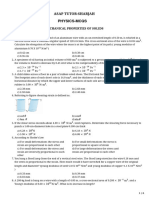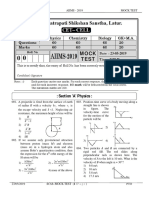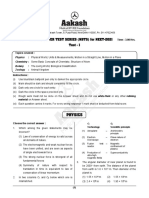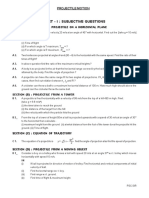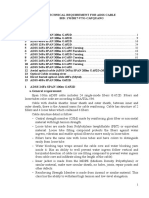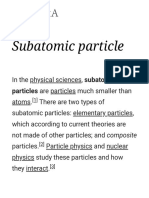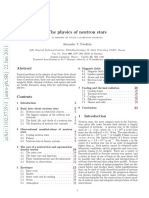06 System of Particles and Rotational Motion
06 System of Particles and Rotational Motion
Uploaded by
MUHAMMED ANAS KCopyright:
Available Formats
06 System of Particles and Rotational Motion
06 System of Particles and Rotational Motion
Uploaded by
MUHAMMED ANAS KOriginal Title
Copyright
Available Formats
Share this document
Did you find this document useful?
Is this content inappropriate?
Copyright:
Available Formats
06 System of Particles and Rotational Motion
06 System of Particles and Rotational Motion
Uploaded by
MUHAMMED ANAS KCopyright:
Available Formats
System of Particles and Rotational Motion PHYSICS
Score:180 Time: 1 Hr NEET 2021
1. From a solid sphere of mass M and radius R, a cube of 9. Two masses m1 and m2 are connected by a massless spring
maximum possible volume is cut. Moment of inertia of cube of spring constant k and unstretched length l. The masses
about an axis passing through its center and perpendicular are placed on a frictionless straight channel, which are
to one of its faces is : consider our x-axis. They are initially at x = 0 and x = l
respectively. At t = 0, a velocity v0 is suddenly imparted to
4MR 2 4MR 2 MR 2 MR 2 the first particle. At a later time t, the centre of mass of the
(a) (b) (c) (d)
9 3p 3 3p 32 2p 16 2p two masses is at :
2. A hollow sphere is held suspended. Sand m2 l
is now poured into it in stages. (a) x = m + m
The centre of mass of the sphere with 1 2
the sand m1l m2 v0t
(a) rises continuously (b) x = m + m + m + m
1 2 1 2
(b) remains unchanged in the process
SAND m2 l m2v0t m2 l m1v0 t
(c) first rises and then falls to the (c) x = + (d) x = m + m + m + m
original position m1 + m1 m1 + m2 1 2 1 2
(d) first falls and then rises to the 10. A body of mass 1.5 kg rotating about an axis with angular
EC
original position velocity of 0.3 rad s–1 has the angular momentum of 1.8 kg
3. A body A of mass M while falling vertically downwards m2s–1. The radius of gyration of the body about an axis is
1 (a) 2 m (b) 1.2 m (c) 0.2 m (d) 1.6 m
under gravity breaks into two parts; a body B of mass M r
3 11. If F is the force acting on a particle having position
2 r r
and a body C of mass M. The centre of mass of bodies vector r and t be the torque of this force about the origin,
3 then:
B and C taken together shifts compared to that of body A
r r r r
towards (a) r . t > 0 and F . t < 0
(a) does not shift r r r r
(b) r . t = 0 and F . t = 0
RS
(b) depends on height of breaking
r r r r
(c) body B (d) body C (c) r . t = 0 and F . t ¹ 0
4. From a uniform wire, two circular loops are made (i) P of r r r r
radius r and (ii) Q of radius nr. If the moment of inertia of Q (d) r . t ¹ 0 and F . t = 0
about an axis passing through its centre and perpendicular 12. A thin uniform rod of length l and mass m is swinging freely
to its plane is 8 times that of P about a similar axis, the value about a horizontal axis passing through its end. Its maximum
of n is (diameter of the wire is very much smaller than r or nr) angular speed is w. Its centre of mass rises to a maximum
(a) 8 (b) 6 (c) 4 (d) 2 height of
5. A billiard ball of mass m and radius r, when hit in a horizontal
direction by a cue at a height h above its centre, acquired a 1 lw 1 l 2w 2 1 l 2w 2 1 l 2w2
(a) (b) (c) (d)
PA
linear velocity v0. The angular velocity w0 acquired by the 6 g 2 g 6 g 3 g
ball is 13. A wheel is rolling straight on ground
5v0 r 2 2v0 r 2 2v0 h 5v0 h without slipping. If the axis of the P
(a) (b) (c) (d)
2h 5h 5r 2 2r 2 wheel has speed v, the instantenous q
6. Three bricks each of length L and Wall velocity of a point P on the rim, defined
mass M are arranged as shown by angle q, relative to the ground will
from the wall. The distance of the be
centre of mass of the system from L/4 æ1 ö æ1 ö
the wall is L/2 (a) v cosç q ÷ (b) 2v cosç q ÷
(a) L/4 (b) L/2 (c) (3/2)L L (d) (11/12)L è2 ø è2 ø
7. Four point masses, each of value m, are placed at the corners (c) v(1+ sin q) (d) v(1+ cos q)
of a square ABCD of side l. The moment of inertia of this 14. A solid sphere having mass m and radius r rolls down an
system about an axis passing through A and parallel to BD is inclined plane. Then its kinetic energy is
(a) 2ml 2 (b) 3ml2 (c) 3ml 2 (d) ml 2 5 2
8. A loop of radius r and mass m rotating with an angular velocity (a) rotational and translational
w0 is placed on a rough horizontal surface. The initial velocity 7 7
of the centre of the hoop is zero.What will be the velocity of 2 5
(b) rotational and translational
the centre of the hoop when it ceases to slip? 7 7
rw0 rw0 rw0 2 3
(a) (b) (c) (d) rw0 (c) rotational and translational
4 3 2 5 5
OPP. PWD REST HOUSE, BALUSSERY, CONTACT: 9946 085 085
KOZHIKODE - 673612 9946 468 468
1 1 (a) 1 : 1 A B
(d) rotational and translational
2 2 (b) 2 : 3
15. A ring of mass M and radius R is rotating about its axis with v
(c) 3 : 2 0
angular velocity w. Two identical bodies each of mass m are (d) 4 : 3
now gently attached at the two ends of a diameter of the 23. Two discs of same thickness but of different radii are made
ring. Because of this, the kinetic energy loss will be :
Mm of two different materials such that their masses are same.
m( M + 2m) 2 2
(a) w R (b) w2 R2 The densities of the materials are in the ratio of 1 : 3. The
M ( M + m)
( M + m) M 2 2 moments of inertia of these discs about the respective axes
Mm
(c) w2 R 2 (d) ( M + 2 m) w R passing through their centres and perpendicular to their
( M + 2m) planes will be in the ratio of
16. Acertain bicycle can go up a n F1
Chai
gentle incline with constant speed (a) 1 : 3 (b) 3 : 1 (c) 1 : 9 (d) 9 : 1
when the frictional force of R2 Roa
d 24. A pulley fixed to the ceiling carries a string with blocks of
ground pushing the rear wheel is R1
mass m and 3 m attached to its ends. The masses of string
F2 = 4 N. With what force F1 must and pulley are negligible. When the system is released, its
4N
the chain pull on the sprocket F2 = centre of mass moves with what acceleration ?
wheel if R1=5 cm and R2 = 30 cm? Horizontal (a) 0 (b) – g/4 (c) g/2 (d) – g/2
35 25. A ring of mass m and radius R has
(a) 4 N (b) 24 N (c) 140 N (d) N
4 four particles each of mass m
17. A wooden cube is placed on a rough horizontal table, a attached to the ring as shown in
EC
force is applied to the cube. Gradually the force is increased. figure. The centre of ring has a speed
Whether the cube slides before toppling or topples before v0. The kinetic energy of the system
sliding is independent of :
(a) the position of point of application of the force is
(b) the length of the edge of the cube (a) mv02 (b) 3mv02 (c) 5mv02 (d) 6mv02
(c) mass of the cube
(d) Coefficient of friction between the cube and the table 26. Consider a uniform square plate of side ‘a’ and mass ‘M’.
18. From a circular ring of mass M and radius R, an arc The moment of inertia of this plate about an axis
corresponding to a 90° sector is removed. The moment of perpendicular to its plane and passing through one of its
inertia of the ramaining part of the ring about an axis passing corners is
through the centre of the ring and perpendicular to the plane
RS
of the ring is k times MR2. Then the value of k is 5 1 7 2
(a) 3/4 (b) 7/8 (c) 1/4 (d) v1 (a) Ma 2 (b) Ma 2 (c) Ma 2 (d) Ma 2
0 6 12 12 3
19. A mass m moves in a circle on a
smooth horizontal plane with 27. A dancer is standing on a stool rotating about the vertical
velocity v0 at a radius R0. The axis passing through its centre. She pulls her arms towards
m
mass is attached to string which the body reducing her moment of inertia by a factor of n.
passes through a smooth hole in The new angular speed of turn table is proportional to
the plane as shown. (a) n (b) n –1 (c) n 0 (d) n 2
The tension in the string is increased gradually and finally
R 28. A uniform square plate has a small piece Q of an irregular
m moves in a circle of radius 0 . The final value of the shape removed and glued to the centre of the plate
PA
2 leaving a hole behind. Then the moment of inertia about
kinetic energy is y y
the z-axis
1 1
(a) mv02 (b) 2mv02 (c) mv02 (d) mv20 (a) increases Hole
4 2 (b) decreases
Q x x
20. A rod PQ of length L revolves in a horizontal plane about the
(c) remains same
axis YY´. The angular velocity of the rod is w. If A is the area
(d) changed in unpredicted manner.
of cross-section of the rod and r be its density, its rotational
29. A circular turn table has a block of ice placed at its centre.
kinetic energy is The system rotates with an angular speed w about an axis
1 1 3 2
(a) AL3rw 2 ` (b) AL rw passing through the centre of the table. If the ice melts on
3 2 its own without any evaporation, the speed of rotation of
1 1 the system
(c) AL3rw 2 (d) AL3rw 2
24 18 (a) becomes zero
21. A solid sphere of mass 2 kg rolls on a smooth horizontal (b) remains constant at the same value w
surface at 10 m/s. It then rolls up a smooth inclined plane of (c) increases to a value greater than w
inclination 30° with the horizontal. The height attained by (d) decreases to a value less than w
the sphere before it stops is 30. Seven identical coins are rigidly arranged on a flat table in
(a) 700 cm (b) 701 cm (c) 7.1 m (d) 70 m the pattern shown below so that each coin touches it
22. A hollow smooth uniform sphere A of mass m rolls without neighbors. Each coin is a thin disc of mass m and radius r.
sliding on a smooth horizontal surface. It collides head on The moment of inertia of the system of seven coins about
elastically with another stationary smooth solid sphere B of an axis that passes through point P and perpendicular to
the same mass m and same radius. The ratio of kinetic energy the plane of the coin is :
of B to that of A just after the collision is
OPP. PWD REST HOUSE, BALUSSERY, CONTACT: 9946 085 085
KOZHIKODE - 673612 9946 468 468
55 2 127 2 111 2 of rotation
(a) mr (b) mr (c) mr (d) 55 mr2
2 2 2 (d) total angular momentum and moment of inertia about
the axis of rotation
31. In a two-particle system with particle masses m1 and m2, the
39. The moment of inertia of a uniform semicircular wire of mass
first particle is pushed towards the centre of mass through m and radius r, about an axis passing through its centre of
a distance d, the distance through which second particle
æ kö
must be moved to keep the centre of mass at the same mass and perpendicular to its plane is mr 2 ç1 - 2 ÷ . Find
position is è p ø
the value of k.
m 2d m1d m1d (a) 2 (b) 3 (c) 4 (d) 5
(a) (b) d (c) (d) m 40. Initial angular velocity of a circular disc of mass M is w 1.
m1 (m1 + m 2 ) 2 Then two small spheres of mass m are attached gently to
32. A uniform bar of mass M and length L is horizontally diametrically opposite points on the edge of the disc. What
suspended from the ceiling by two vertical light cables as is the final angular velocity of the disc?
shown. Cable A is connected 1/4th distance from æ M + mö æ M + mö
the left end of the bar. Cable (a) çè ÷ w1 (b) çè ÷ w1
B is attached at the far right Cable A Cable B M ø m ø
1
end of the bar. What is the 4 L æ M ö æ M ö
(c) çè ÷w (d) ç w.
tension in cable A? L M + 4m ø 1 è M + 2m ø÷ 1
(a) 1/4 Mg (b) 1/3 Mg (c) 2/3 Mg (d) 3/4 Mg 41. Two identical discs of mass m and radius r are //////////////////
EC
33. A couple produces arranged as shown in the figure. If a is the
(a) purely linear motion angular acceleration of the lower disc and acm
(b) purely rotational motion is acceleration of centre of mass of the lower
(c) linear and rotational motion disc, then relation between a cm ,
a and r is
(d) no motion (a) acm = a/r (b) acm = 2ar
34. Point masses 1, 2, 3 and 4 kg are lying at the point (0, 0, 0), (c) acm = a r (d) None of these
(2, 0, 0), (0, 3, 0) and (–2, –2, 0) respectively. The moment of 42. Five masses are placed in a plane as shown in figure. The
inertia of this system about x-axis will be coordinates of the centre of mass are nearest to
(a) 43 kgm2 (b) 34 kgm2 (c) 27 kgm2 (d) 72 kgm2 y
(a) 1.2, 1.4 2 3 kg 4 kg
35. A solid sphere of mass M and
RS
radius R is pulled horizontally on (b) 1.3, 1.1
a sufficiently rough surface as 5 kg
1
shown in the figure. (c) 1.1, 1.3
Choose the correct alternative.
(a) The acceleration of the centre of mass is F/M (d) 1.0, 1.0 0 1 kg 2 kg x
0 1 2
2 F 43. Three particles, each of mass m gram, are situated at the
(b) The acceleration of the centre of mass is
3M vertices of an equilateral triangle ABC of side l cm (as shown
(c) The friction force on the sphere acts forward in the figure). The moment of inertia of the system about a
(d) The magnitude of the friction force is F/3 line AX perpendicular to AB and in the plane of ABC, in
36. The moment of inertia of a body about a given axis is gram-cm2 units will be
PA
X
1.2 kg m2. Initially, the body is at rest. In order to produce a 3 2
rotational kinetic energy of 1500 joule, an angular (a) ml m C
2
acceleration of 25 radian/sec2 must be applied about that
3
axis for a duration of (b) ml 2 l l
(a) 4 sec (b) 2 sec (c) 8 sec (d) 10 sec 4
37. A gymnast takes turns with her arms and legs stretched. (c) 2 ml2
A B
When she pulls her arms and legs in 5
(a) the angular velocity decreases (d) ml 2 m l m
4
(b) the moment of inertia decreases 44. When a ceiling fan is switched on, it makes 10 rotations in
(c) the angular velocity stays constant the first 3 seconds. Assumin g a un iform an gular
(d) the angular momentum increases acceleration, how many rotation it will make in the next 3
38. An equilateral triangle ABC formed from A seconds?
a uniform wire has two small identical (a) 10 (b) 20 (c) 30 (d) 40
beads initially located at A. The triangle is g
45. A solid sphere spinning about a horizontal axis with an
set rotating about the vertical axis AO. angular velocity w is placed on a horizontal surface.
Then the beads are released from rest Subsequently it rolls without slipping with an angular
simultaneously and allowed to slide B C velocity of :
O
down, one along AB and the other along AC as shown. 2w 7w 2w
Neglecting frictional effects, the quantities that are conserved (a) (b) (c) (d) w
5 5 7
as the beads slide down, are
(a) angular velocity and total energy (kinetic and potential)
(b) total angular momentum and total energy
(c) angular velocity and moment of inertia about the axis
OPP. PWD REST HOUSE, BALUSSERY, CONTACT: 9946 085 085
KOZHIKODE - 673612 9946 468 468
You might also like
- Lab 10 Polarization 2Document9 pagesLab 10 Polarization 2Prashant Gupta100% (1)
- Asap-Mechanical Properties of Solids-McqsDocument6 pagesAsap-Mechanical Properties of Solids-McqsjimmyemandeeNo ratings yet
- Electrostatics: Electrostatics Jee - Advanced Vol - ViDocument20 pagesElectrostatics: Electrostatics Jee - Advanced Vol - ViArnav Vikas GargNo ratings yet
- Module 1. Calculus 3Document31 pagesModule 1. Calculus 3Manuel Francisco100% (3)
- ASTM D6373 Standard Specification For Performance Graded Asphalt BinderDocument5 pagesASTM D6373 Standard Specification For Performance Graded Asphalt Binderbeatriz adriana salazar cruzNo ratings yet
- Class Xi Chemical EquilibriumDocument3 pagesClass Xi Chemical Equilibriumrajdeep gangulyNo ratings yet
- 02 Motion in One Dimension PDFDocument51 pages02 Motion in One Dimension PDFbrcrao100% (1)
- 11th Physics NEET 1 Mark Vol-2 EMDocument53 pages11th Physics NEET 1 Mark Vol-2 EMjohnsonNo ratings yet
- 11th Physics NEET 1 Mark Vol-1 EMDocument47 pages11th Physics NEET 1 Mark Vol-1 EMjohnsonNo ratings yet
- Motion in Two Dimension - Practice ProblemsDocument15 pagesMotion in Two Dimension - Practice ProblemsAvik PatraNo ratings yet
- PHYSICS Previous Years Question PapersDocument33 pagesPHYSICS Previous Years Question Papersdiya patelNo ratings yet
- Important Questions: Class-11 Chapter-2 Topic-Units & MeasurementDocument6 pagesImportant Questions: Class-11 Chapter-2 Topic-Units & MeasurementShady WeebNo ratings yet
- WORK, POWER, ENERGY & MOMENTUM Important QuestionsDocument18 pagesWORK, POWER, ENERGY & MOMENTUM Important QuestionsRavindra KumarNo ratings yet
- Aakash dpp1 PDFDocument4 pagesAakash dpp1 PDFramNo ratings yet
- Alternating Current - Ex # 1 - 4Document19 pagesAlternating Current - Ex # 1 - 4Sagar AroraNo ratings yet
- Test - 6: (Science)Document21 pagesTest - 6: (Science)ptv7105No ratings yet
- System of Particles NarayanaDocument97 pagesSystem of Particles NarayanaJanarthan SekarNo ratings yet
- Narayana Medical Academy: IndiaDocument18 pagesNarayana Medical Academy: IndiaGowri ShankarNo ratings yet
- Physics Spectrum December 2015 PDFDocument100 pagesPhysics Spectrum December 2015 PDFParvinder BhardwajNo ratings yet
- Physics Gravitation Advanced AssignmentDocument10 pagesPhysics Gravitation Advanced AssignmentdxddxishxerxNo ratings yet
- Aakash 08 - Solids and FluidsDocument14 pagesAakash 08 - Solids and FluidsChanduNo ratings yet
- NEET UG Physics Atom and Nucleus MCQsDocument36 pagesNEET UG Physics Atom and Nucleus MCQsKapila KarthikeyanNo ratings yet
- SR Chaina Grand Test - Ex Date - 31-12-2018 - QP PDFDocument20 pagesSR Chaina Grand Test - Ex Date - 31-12-2018 - QP PDFShivalgiri GoswamiNo ratings yet
- Gravitaion DPPDocument20 pagesGravitaion DPPAkash MukherjeeNo ratings yet
- Allen Rohtak: Current ElectricityDocument2 pagesAllen Rohtak: Current ElectricityyashNo ratings yet
- AIIMS Mock QPaper PDFDocument21 pagesAIIMS Mock QPaper PDFSangram Munde100% (1)
- 12 Neet Assignment Laws of Motion .Document4 pages12 Neet Assignment Laws of Motion .adv vsdvNo ratings yet
- Part - I: Subjective Questions: Section (A) : Definition, Projectile On A Horizontal PlaneDocument10 pagesPart - I: Subjective Questions: Section (A) : Definition, Projectile On A Horizontal PlaneAditya SahayNo ratings yet
- Moving Charges ObjectiveDocument6 pagesMoving Charges ObjectiveAnandNo ratings yet
- Grade 11 - Physics - MOTION IN A PLANE - Narayana Meterial - WorksheetDocument31 pagesGrade 11 - Physics - MOTION IN A PLANE - Narayana Meterial - Worksheetsiraj123.daniNo ratings yet
- 11th DPP 1D Kinematic-1Document5 pages11th DPP 1D Kinematic-1SaήjaγKsNo ratings yet
- DPP - 01 - ElectrostaticsDocument4 pagesDPP - 01 - ElectrostaticsPubg prakhar PrakharNo ratings yet
- (@TEAMFLOOD) Physical World - Aakash RM Modules PDFDocument6 pages(@TEAMFLOOD) Physical World - Aakash RM Modules PDFtejas naigaonkarNo ratings yet
- Course: Newton's Laws of Motion: Presented by Kailash SharmaDocument53 pagesCourse: Newton's Laws of Motion: Presented by Kailash SharmaShin ChanNo ratings yet
- Allen Kota Test Papers (Medical)Document47 pagesAllen Kota Test Papers (Medical)Dr AwesomeNo ratings yet
- Wave OpticsDocument6 pagesWave Opticsbhnprtp90No ratings yet
- Centre of Mass and Collision PDFDocument24 pagesCentre of Mass and Collision PDFddNo ratings yet
- Gaurav Arora: Target 2021 DPP - 3Document4 pagesGaurav Arora: Target 2021 DPP - 3Devansh SangwanNo ratings yet
- (Practise Sheet) Motion in 1D JEE Mains + NEETDocument21 pages(Practise Sheet) Motion in 1D JEE Mains + NEETNazneen AktarNo ratings yet
- CirclesDocument2 pagesCirclesbhartiyaanujNo ratings yet
- JEE Mains Q.bank Circular MotionDocument63 pagesJEE Mains Q.bank Circular MotionTapankumar Sanyal50% (4)
- Electrostatics: Chapter - 03Document22 pagesElectrostatics: Chapter - 03Maheedhar A.MNo ratings yet
- Plus One Physics Previous Question PaperDocument44 pagesPlus One Physics Previous Question Papersidharth7manoj75% (4)
- Motion in Plane NEET JEE Practice QuestiosDocument174 pagesMotion in Plane NEET JEE Practice QuestiosjothilakshmiNo ratings yet
- YCT Motion in One Dimensions NEET JEE Practice QuestionsDocument210 pagesYCT Motion in One Dimensions NEET JEE Practice QuestionsjothilakshmiNo ratings yet
- Electric Charges & Fields - QP 1Document6 pagesElectric Charges & Fields - QP 1Bolt FF100% (1)
- Part 04 SET (251 - 252)Document3 pagesPart 04 SET (251 - 252)KartikNo ratings yet
- 3.wave Optics Final - PMDDocument32 pages3.wave Optics Final - PMDArnav Vikas GargNo ratings yet
- CLS Aipmt-17-18 XI Phy Study-Package-3 SET-2 Chapter-9 PDFDocument46 pagesCLS Aipmt-17-18 XI Phy Study-Package-3 SET-2 Chapter-9 PDFNutan JhaNo ratings yet
- Dual Nature of Radiation and Matter Classwork 2021Document4 pagesDual Nature of Radiation and Matter Classwork 2021Siddhesh KultheNo ratings yet
- Modern Physics - Exercise - 1Document5 pagesModern Physics - Exercise - 1Gaurav KumarNo ratings yet
- System of Particles & Rotational Motion: SolutionsDocument50 pagesSystem of Particles & Rotational Motion: SolutionsKrishna Bhadra100% (1)
- Class XI Physics DPP Set (05) - Mathematical Tools & Kinematics PDFDocument10 pagesClass XI Physics DPP Set (05) - Mathematical Tools & Kinematics PDFAshish RanjanNo ratings yet
- NEET Ray Optics Important Questions - Free PDF DownloadDocument28 pagesNEET Ray Optics Important Questions - Free PDF DownloadkavithavenkatesanNo ratings yet
- Neet Booster Test Series (NBTS) For Neet-2021 Test - 1: PhysicsDocument17 pagesNeet Booster Test Series (NBTS) For Neet-2021 Test - 1: PhysicsMangesh VeerNo ratings yet
- NEET GT-2 KeyDocument8 pagesNEET GT-2 Keyabcxyz7799No ratings yet
- Lom TopicwiseDocument35 pagesLom Topicwisedd100% (1)
- Motion in A Straight Line DPP 03 of Lec 04 Yakeen NEET 2025Document3 pagesMotion in A Straight Line DPP 03 of Lec 04 Yakeen NEET 2025bindhur219No ratings yet
- II Puc PCMB Neet Toppers QP 26-11-2023Document27 pagesII Puc PCMB Neet Toppers QP 26-11-2023naveenn0803No ratings yet
- Relative Motion FiitjeeDocument4 pagesRelative Motion FiitjeeSoumabho PalNo ratings yet
- Part - I: Subjective Questions: Projectile MotionDocument5 pagesPart - I: Subjective Questions: Projectile MotionAtul100% (1)
- Eamcet '13 PDFDocument44 pagesEamcet '13 PDFAmaan YousufNo ratings yet
- Work Power Energy JEE TestDocument6 pagesWork Power Energy JEE TestAman RolandNo ratings yet
- CTKT Adss VTGDocument146 pagesCTKT Adss VTGVô CảmNo ratings yet
- Subatomic ParticlesDocument25 pagesSubatomic ParticlesmelprvnNo ratings yet
- SJPO Sample QuestionsDocument4 pagesSJPO Sample QuestionsunknownNo ratings yet
- Chemistry 1 11 Q2 M1Document14 pagesChemistry 1 11 Q2 M1Gaelle Mariposa100% (1)
- Well Control AssignmentDocument9 pagesWell Control AssignmentMathias NsimbeNo ratings yet
- The Physics of Neutron StarDocument28 pagesThe Physics of Neutron StarAlberto SernaNo ratings yet
- Detailed Lesson Plan in Mathematics (Trigonometry) : I. ObjectivesDocument7 pagesDetailed Lesson Plan in Mathematics (Trigonometry) : I. Objectivesnos rejNo ratings yet
- Design Analysis of A Refrigerated Warehouse Using LNG Cold EnergyDocument10 pagesDesign Analysis of A Refrigerated Warehouse Using LNG Cold EnergyJSK1 JSK11No ratings yet
- Experiment 6: Gas Pressure Control Using Pid Controller ObjectivesDocument5 pagesExperiment 6: Gas Pressure Control Using Pid Controller ObjectivesPMNo ratings yet
- ASME Y14.5 M - 1994 - Dimensioning and TolerancingDocument12 pagesASME Y14.5 M - 1994 - Dimensioning and TolerancingDimitri MantauNo ratings yet
- Beat The Clock (H)Document2 pagesBeat The Clock (H)Joseph ManojNo ratings yet
- Determination of Thermal Properties of Roxul Mineral Wool For Fire Modeling Purposes - Master's Thesis WaterlooDocument99 pagesDetermination of Thermal Properties of Roxul Mineral Wool For Fire Modeling Purposes - Master's Thesis Waterloofire-1No ratings yet
- 9I Forces & Motion Year 9 NotesDocument100 pages9I Forces & Motion Year 9 Notesebrahimb5253No ratings yet
- Grade 9 Integrated Common SchemesDocument11 pagesGrade 9 Integrated Common Schemeszaphaniakip04No ratings yet
- Possible Errata For Theoretical Minimum-Quantum MechanicsDocument3 pagesPossible Errata For Theoretical Minimum-Quantum MechanicsTomCafez100% (1)
- EZ Torque: Hydraulic Cathead User's ManualDocument35 pagesEZ Torque: Hydraulic Cathead User's ManualJuan Garcia100% (1)
- 100 GFHU ManualDocument18 pages100 GFHU ManualGelu BarbulescuNo ratings yet
- CBSE Board Class X Mathematics Sample Paper 3Document5 pagesCBSE Board Class X Mathematics Sample Paper 3Mausam KumarNo ratings yet
- Morsi 1972Document17 pagesMorsi 1972Julio HerreraNo ratings yet
- Setting Out NotesDocument2 pagesSetting Out NotesNde CedricNo ratings yet
- Connecting Rod CalculationsDocument2 pagesConnecting Rod CalculationsArasu Pandian100% (1)
- The Sweet Spots of A Tennis RacketDocument17 pagesThe Sweet Spots of A Tennis RacketAsad MazherNo ratings yet
- Department of Physics, Federal University of Technology, Yola. Department of Architecture, Federal University of Technology, YolaDocument6 pagesDepartment of Physics, Federal University of Technology, Yola. Department of Architecture, Federal University of Technology, YolaRoi KimssiNo ratings yet
- Activity Sheet No.9 History of ElectricityDocument4 pagesActivity Sheet No.9 History of ElectricityMarites TagaytayanNo ratings yet
- Kailas SarodeDocument12 pagesKailas SarodeMayur PoteNo ratings yet
- Review Test 24 p1 PCM Sol. - Jee Adv.Document14 pagesReview Test 24 p1 PCM Sol. - Jee Adv.Venkatakrishnan ANo ratings yet
- Amada Miyachi Yag Laser Welder Ml2052aDocument2 pagesAmada Miyachi Yag Laser Welder Ml2052aRick ChenNo ratings yet

